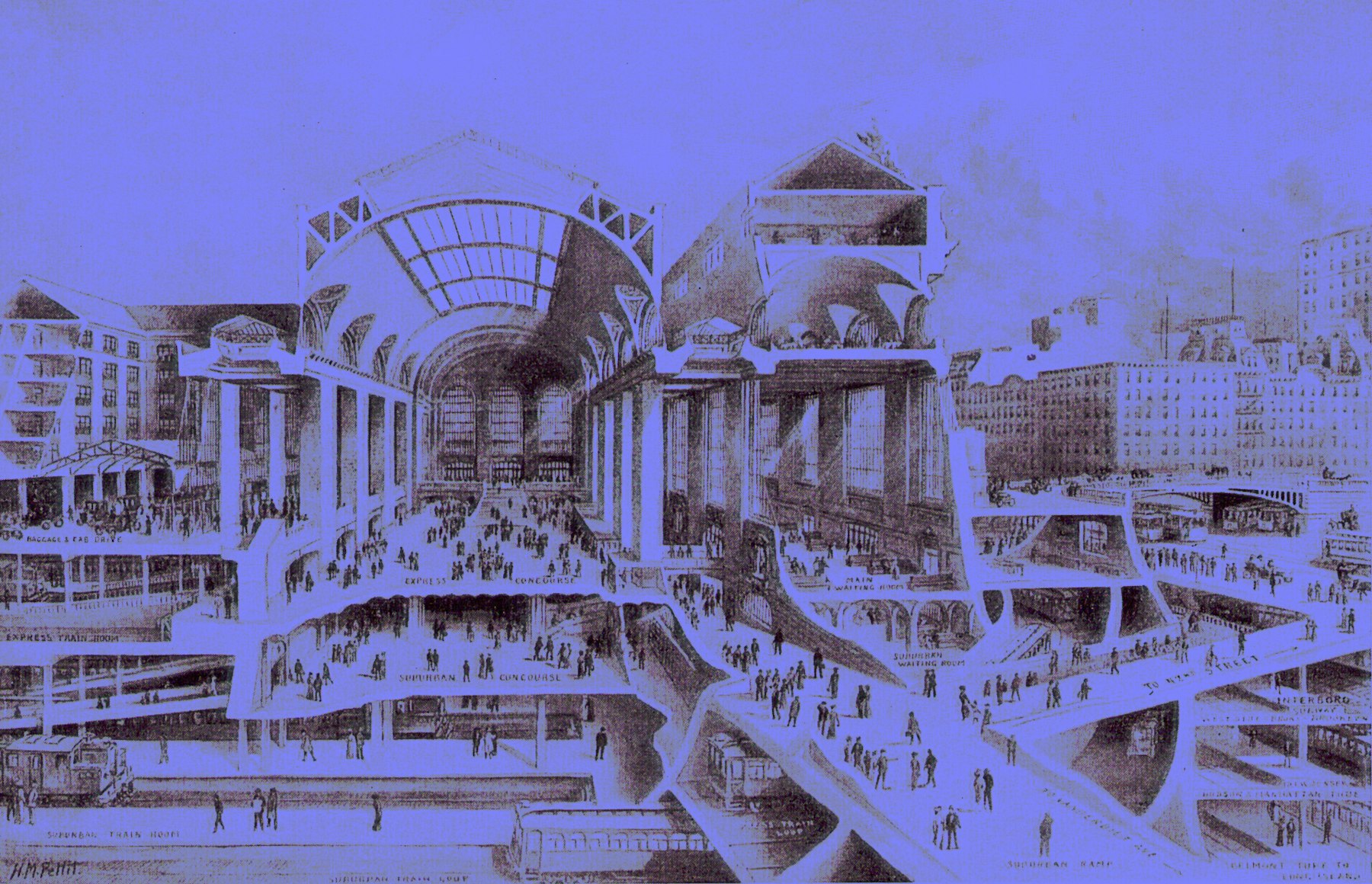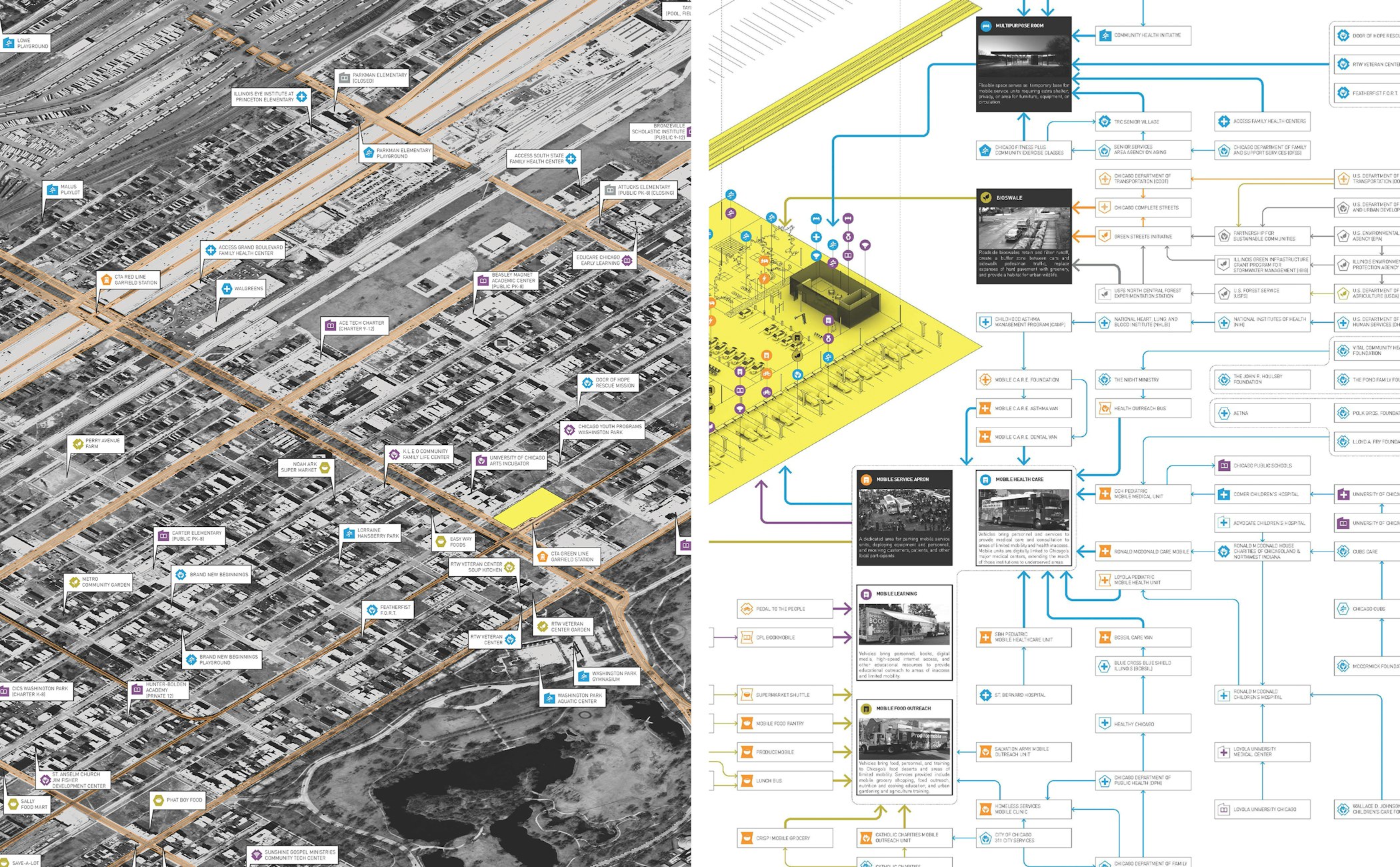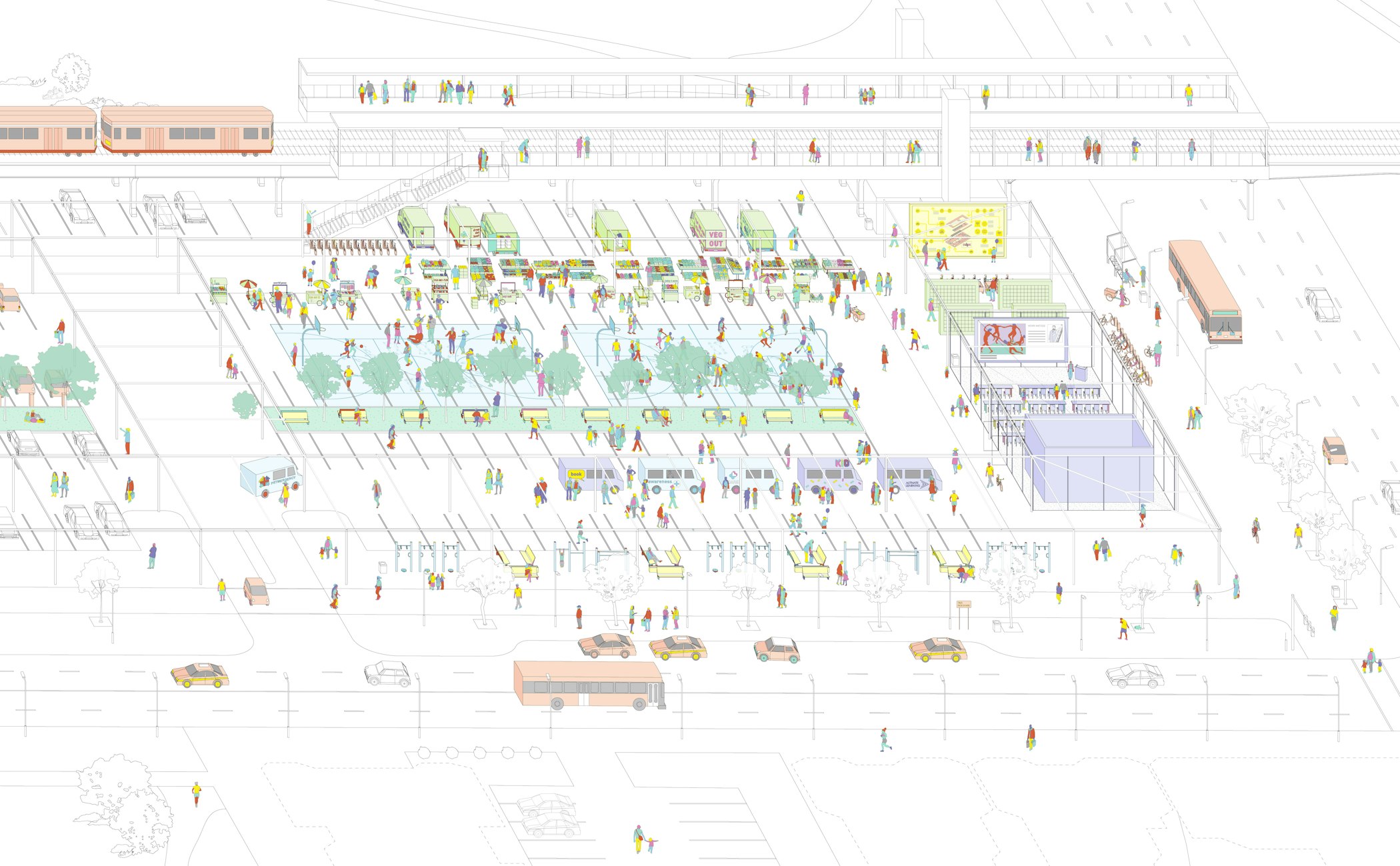Infrastructure networks are thus involved in sustaining what we might call “sociotechnical geometries of power” in very real—but often complex—ways. They tend to embody “congealed social interests.” ... The construction of spaces of mobility and flows for some, however, always involves the construction of barriers for others. Experiences of infrastructures are therefore highly contingent. ... We must therefore recognise how the configurations of infrastructure networks are inevitably imbued with biased struggles for social, economic, ecological and political power to benefit from connecting with (more or less) distant times and places.
Infrastructure: BETWEEN RELATIONS AND THINGS
While physical urban infrastructures such as road networks, bridge structures, port complexes, and hydrological systems have for millennia defined the anatomy and configuration of cities, the term “infrastructure” itself is a relatively modern one. Moreover, it is a word that historian Rosalind Williams has described as being “promiscuous,” with meaning varying by context[1]. Anthropologists Susan Leigh Star and Karen Ruhleder argue that “infrastructure is fundamentally always a relation, never a thing.”[2] To understand “infrastructure” simultaneously as relations and material things, in contextual assemblages, has the capacity to transform the way we imagine and structure urban life.
The first use of the term “infrastructure” occurs in late-nineteenth-century technical literature in France and England related to railroad construction, where the word is used in reference to the logistics, planning, and subsurface preparations for tracks and other associated structures to deliver the physical system[3]. Here note the prefix “infra-” referring to the condition of being beneath, undergirding what is to come. “Infrastructure” remained a fairly obscure word until the 1950s, when it was appropriated by NATO as “a generic term to denote all those fixed installations which are necessary for the effective deployment and operations of modern armed forces.”[4] In this open-ended definition, it included not only physical installations (highways, bridges, railroads, airports, military bases), but also facilities for communications, power, irrigation, and flood control, as well as warehousing, storage depots, fuel supplies, and the funding frameworks and coordination necessary to enable these installations.[5] In this usage, the term became not only more expansive in its scope but also explicitly politicized, toward military power and control of urbanization. This appropriation of the term illustrates appropriation of existing systems themselves—into new networks, hierarchically reconfigured in support of other objectives.
During the societal transformations of the 1960s and 70s, the definition of “infrastructure” continued to shift. By then, most usage had moved the term away from its military associations and began to be more closely related to government-sponsored economic and social development, often “treated as a synonym of social overhead capital, meaning capital goods like roads, schools, hospitals, and public parks that are broadly available to the public and typically provided by the government.”[6] The word was also adopted into business and organizational vocabularies, referring to social-technical networks for providing these new social-capital goods. In the 1980s, President Ronald Reagan referred to the “infrastructure of democracy—the system of a free press, unions, political parties, universities.”[7] In the 1990s President Bill Clinton’s Commission on Critical Infrastructure defined it as “a network of independent, mostly privately-owned, man-made systems and processes that function collaboratively and synergistically to produce and distribute continuous flow of essential goods and services.”[8]
Within the design disciplines of architecture, landscape, and urban design, “infrastructure” has most commonly been used to refer to the engineered systems of transportation, water, power, and communications. In the twentieth century, the design and implementation of these systems became the specialist purview of the engineering professions. In this context, the term referred more to material productions than to relational systems. Much of this bias remains: in the United States, for example, the Office of Infrastructure continues to sit within the U.S. Department of Transportation, which emphasizes roadbuilding.[9]
Today, the term “infrastructure” suggests new priorities and assemblages. Reinterpreting the word for the times, anthropologist Ashley Carse writes, “As a form of calculative reason, infrastructure promises to collect a heterogeneous, changing group of elements ‘beneath’ some higher-order goal.” The fact that “infrastructure” has historically been a highly malleable term that refers to both relational systems and to actual things is not without consequence.
RESILIENT INFRASTRUCTURE
Thus, the 2000s have witnessed a reengagement with infrastructure by the design disciplines, both at the building scale of mechanical and electrical systems and at the urban scale of mobility, logistics, and landscape management.[10] This has been accompanied by a renewed interest in systems thinking and systems approaches across design disciplines.[11] With these priorities comes a shift away from engineering separate physical networks (such as roads) toward a more integrative design of more adaptable city services, under better modeled performance criteria: energy conservation, renewable energy integration, water and resource conservation, environmental remediation, alternatives to personal vehicle-dominated mobility, and the rapid urbanization of city regions. Because so many existing large-scale physical infrastructures built in the last century have been reaching a critical end-of-lifespan condition, designers have recognized that massive government investment in their rehabilitation or replacement can be leveraged toward new priorities and means of environmental and social performance.[12]
Systems thinking privileges ecological and biological models, in which emergent dynamics matter more and reductive engineered optimization has less authority. This precipitates a paradigm shift in how infrastructure is being conceived and implemented. Today’s infrastructural works cannot be thought of within the siloed bounds of a particular system, and cannot continue to be designed through traditional mechanical models of isolated performance. Systems ecologies are more relational: public works should be recognized as dynamically intertwined with biophysical and human systems, exchanging matter, energies, and information beyond the artifacts that are present in these systems. Instead of centralized, energy-intensive, monofunctional systems, designers, planners, and policymakers are increasingly considering distributed, low-energy, multifunctional, and often redundant systems, which are believed to be more resilient to disaster and risk and can be more adaptive over time.[13] Architect Hillary Brown refers to this “interconnected, multipurpose, and synergistic” systems ecology as “next generation infrastructure.”[14] Environmentalist David Orr points out that “properly engaged, nature will in fact do a great deal of the work in engineered systems for free.”[15] Faced with such opportunity and challenge, disciplinary categories of infrastructure, urbanism, and landscape intertwine.[16] Under this paradigm shift, infrastructures cannot be designed and implemented by engineers alone. Projects now require coordination and cooperation among more diverse teams, where more speculative designers, with their ability to envision new futures and to think synthetically about how such efforts may be realized, have a prominent role at the table along with engineers, computer scientists, biologists, planners, sociologists, economists, policy-makers, historians, and community members.
MULTIFUNCTIONAL INFRASTRUCTURES
During the early to mid-20th century, the U.S. laid hundreds of thousands of miles of monofunctional infrastructure in the form of freeways, which in cities often cut brutally through neighborhoods with devastating effects on urban life.[17] There are, however, some notable cases of multifunctional infrastructure built in that period that provide powerful examples of how public amenity coupled with large scale physical infrastructure can in fact strengthen neighborhoods as opposed to dividing them. New York City’s The Brooklyn Heights Promenade is a public belvedere constructed over the cantilevered sections of the Brooklyn-Queens Expressway (BQE) in Brooklyn Heights. This inventive solution to urban freeway construction was the result of powerful lobbying by wealthy and influential residents of Brooklyn Heights in response to Commissioner Robert Moses’s plans to run the new freeway through the space of residents’ private gardens, which were constructed on top of warehouses creating an embankment and lining Furman Street below. The compromise reached with the Planning Commission in 1943 was to construct a cantilevered divided highway in the space of the embankment of the Heights, and to cover this with a deck that would become a public promenade, managed by the Department of Transportation [Figs. 1 & 2].[18]
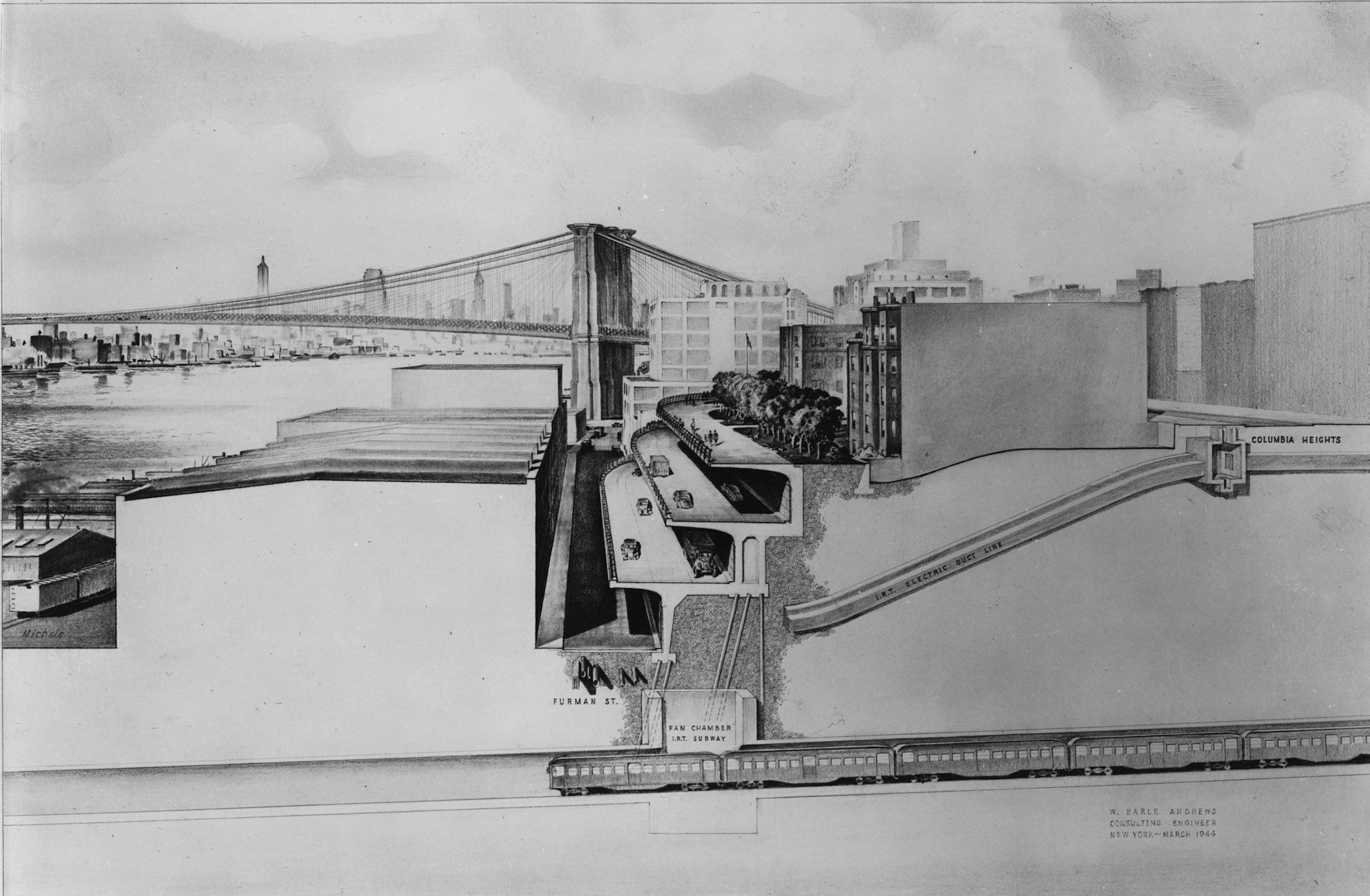
[Fig. 1] Section through the Brooklyn-Queens Expressway. Circa 1950. Photo courtesy of Brooklyn Daily Eagle photographs—Brooklyn Public Library—Brooklyn Collection.
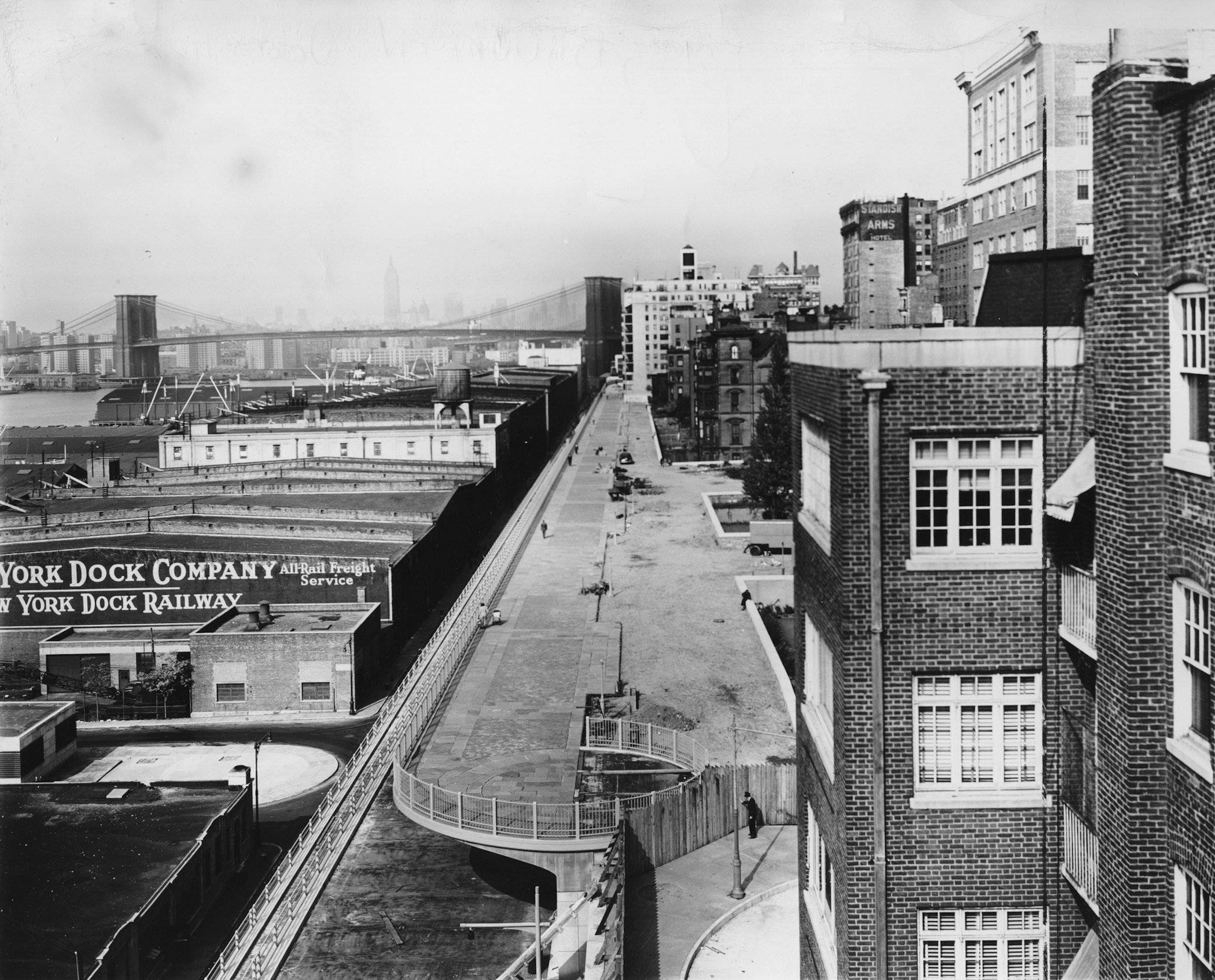
[Fig. 2] The Brooklyn Heights Promenade under construction, 1949. Photo courtesy of Brooklyn Daily Eagle photographs—Brooklyn Public Library—Brooklyn Collection.
Over the 60+ years since its construction, the Brooklyn Heights Promenade has become one of the city’s most well-known and cherished public spaces. From the belvedere, one is rarely aware of the freeway below. This is one of the rare cases of a neighborhood whose property values did not diminish after the construction of the freeway. Brooklyn Bridge Park, designed by Michael Van Valkenburgh and Associates and completed in 2016, now extends along the riverfront in front of the cantilevered highway providing further amenity to the area. At this writing, New York City has been in the midst of a heated series of public meetings on the necessary replacement of the deteriorated BQE decks, now an unwelcome backdrop to the waterfront park, and considering a very costly buried option, as well as even eliminating part of the freeway altogether [Fig. 3].[19]

[Fig. 3] Brooklyn-Queens Expressway, view of the triple cantilever from below. © Benjamin Norman, 2019
The Brooklyn Heights Promenade and Expressway presents a compelling typology of layered public landscape and mobility space, leveraging the sectional separation to provide social and spatial amenity. Recent public space projects like the High Line, designed by Diller Scofidio + Renfro Architects with landscape architecture by James Corner Field Operations, and the East River Waterfront Park and Promenade by SHoP architects both exemplify this spatial and programmatic strategy. While the High Line in particular has been heavily criticized for being a catalyst for the runaway gentrification that has occurred within its proximity, social scientist Eric Klinenberg argues that these types of spaces nonetheless provide an important component of urban social infrastructure for residents, and are often realized only through strategic partnerships between cities, nonprofits, and civic organizations.[20]
METROPOLITAN NODES AND KNOTS
Any new approach to the social and cultural dimensions layered and multifunctional transportation infrastructures might also rediscover the theatricality of New York’s early 20th century railway terminals: Pennsylvania Station (McKim, Mead, White, 1910) and Grand Central Station (Reed and Stem in collaboration with Warren and Wetmore, 1913). Notorious enough a story not to need retelling in limited space here, the 1963 demolition of the Pennsylvania Station remains a watershed in New York’s understanding of arrivals, walking, historic preservation, and much else too.[21] Yet for the purposes of rethinking intertwined systems dynamics as the stuff of imaginative design today, briefly note a few key insights drawn from illustrations of these projects at the time of their conception.
In network theory the spaces where systems cross, with transfers between networks, are referred to as “nodes.” In the city, the nodes of transportation networks are its stations, terminals, and ports. Providing transfer between multiple flows, speeds, and trajectories, these structures also operate as gateways to cities, thresholds to other places, material artifacts of collapsed geographies made possible through the technologies of transportation. As buildings they also negotiate between speeds, scales, and atmospheres; between the apparatus of transportation and the pedestrian city street. A cutaway section-perspective of Pennsylvania Stationfrom 1908 communicates the project’s design intent as a grand, multilayered urban fragment, intertwined with the movements of the great locomotive machines and the human movements of the city. The drawing by illustrator H.M Petit depicts it as endless, its edges extending beyond the boundaries of the frame, urban room after urban room, layered upon levels of service spaces and tracks. The inclusion of the railway levels in the front of the section emphasizes its networked condition as an architectural and urban ambition [Fig. 4]. The activity and movement of the multitude that would come to define the modern democratic and capitalist city is also captured in the depiction of masses of people, occupying and flowing through every accessible space within this rendering of the civic complex. As civic architecture, the urban railway terminal at the turn of the century dramatizes arrival and departure.[22]
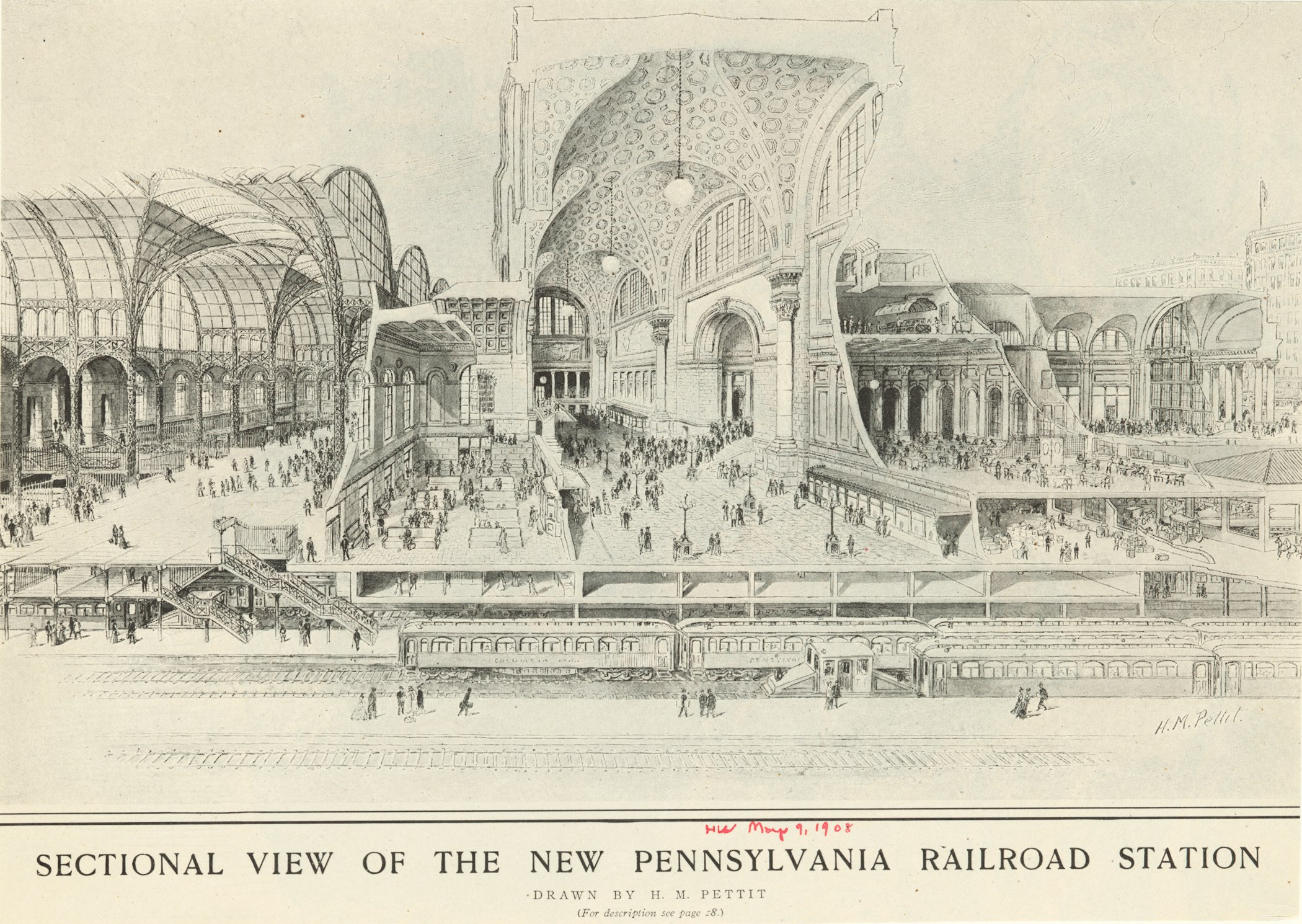
[Fig. 4] Sectional view of the new Pennsylvania Railroad Station. Drawn by H. M. Pettit, 1908. Courtesy of The Miriam and Ira D. Wallach Division of Art, Prints and Photographs: Picture Collection, The New York Public Library Digital Collections.
Grand Central Terminal, completed five years later, took the spectacle of human movement even further. Here, the large machines that enable the volumes of human flow are no longer showcased, coming and going via multiple levels of underground tunnels and chambers. Instead, “the crowd itself became an object to be aestheticized,” collected in its ideal form within the singular monumental concourse and its overlooking galleries, and then dispersed among the intertwined halls, ramps, and walkways that weave the many trajectories of passenger trains back onto the grid of the surrounding city in a “theater of circulation.”[23] [Fig. 5]
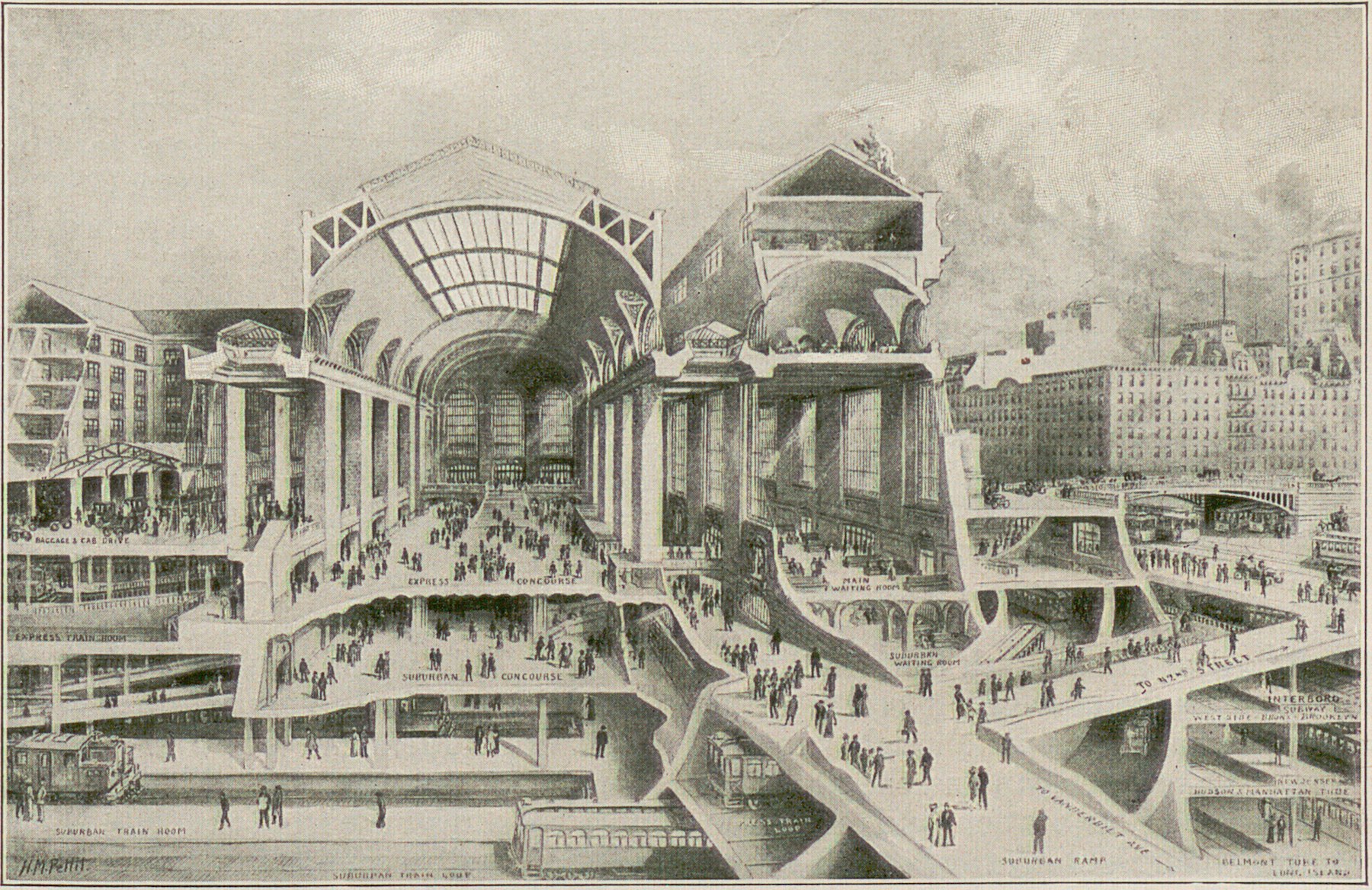
[Fig. 5] Section of Grand Central Terminal. Drawn by H. M. Pettit. Scribner’s Magazine v.52, 1912.
As capital projects, these grand terminals (not only in New York but throughout the US of that era) were also conceived of and designed as microcosms of cities within themselves, a spectacle not only of mobility but also of commerce.[24] Grand Central Terminal was described as being closer to a “bazaar” than a station, and a destination for people without even needing to board the trains.[25] Meanwhile these terminals also facilitated retail abundance in their vicinities, particularly in New York’s culture of the big department stores, and continuing to draw regional patrons and ever-increasing numbers of tourists today. Although the economic dominance of the transcontinental railroads soon waned in the 20th century, the role of layered mobility nodes in urban development is only more important today.
As monuments to centralized power, however, these great terminals might be met more with nostalgia, as well as apologetics for the era’s imperialism.[26] Today, as a new phase of federal infrastructure spending takes form, a larger greener new deal 2.0 still beckons, and emergent complexities of systems seem all the more vital, new structures will most often need to be conceived as adaptations, modifications, and grafts onto what has previously been constructed. Designers and planners will also need to ask themselves important questions beyond the instrumentality and performance of these works such as: for whom these infrastructures will be built, what kind of collective and social space will they produce, and whose finances will build and operate them? In addition, designers will need to be conscious of the materialization and architectural expression of these infrastructures and their potential material politics. As political theorist Langdon Winner has argued, “The issues that divide or unite people in society are settled not only in the institutions and practices of politics proper, but also, and less obviously, in tangible arrangements of steel and concrete, wires and transistors, nuts and bolts.”[27]
MOBILITY SPACE AS SOCIAL INFRASTRUCTURE
Social infrastructure is the network of physical spaces and institutions—from sidewalks to public parks, libraries to cafes—that, when robust, promote community-building activities among otherwise diverse clans… The stakes are real: Weak social infrastructure breeds economic isolation, political misunderstanding, and the social divisions that fuel the most dangerous forms of xenophobia.
The urban condition of many U.S. cities is characterized by drastically uneven development, highly asymmetrical distribution of urban services, and deepening injustice overall particularly for Black communities.[28] [29] The neoliberal playbook of urban redevelopment proves impotent when imagining how social infrastructure, access to needs, and the public realm can be improved without new market-driven housing and commercial development.[30] According to sociologist Saskia Sassen, these conditions go beyond conventional discourses of inequality, implicating networks of systems, institutions, and instruments that operate through the logics of complexity.[31] To counter these trends, a growing body of research undertaken by human geographers, social scientists, and anthropologists makes a convincing case for the importance of social infrastructure as an essential component of an inclusive and democratic city.[32]
Returning to the premise that “infrastructure” is a malleable term assembling things into interrelationships that serve higher-level goals, forward-looking design now reconsiders the social as the most vital component of a more integrative systems thinking. Places of gathering belong in the infrastructure conversation too: public institutions such as libraries or community centers, commercial establishments such as coffee shops, recreational spaces, religious spaces, and yes, more multilayered transit spaces.[33] Beyond fulfilling their instrumental functions, “social infrastructures are necessary… also for addressing and preventing some of the most pressing concerns of contemporary urban life: countering social isolation, negotiating difference, and creating places for all.”[34] In times of environmental disaster, social infrastructure can impact community resilience, mortality, and social stabilization.[35] This must be framed as imaginative work, in which so many smaller adaptations and grafts together shift some larger sense of priorities and what is possible.
Through some of our recent design work in this space, we speculate on the potential to leverage funding directed toward the improvement of public transportation systems, as well as the spaces adjacent to transportation structures, as cooperative actors in new distributed socio-spatial assemblages that aim to increase equitable public life in cities. This work reconceives the space of transit infrastructure as a physical platform that can be appropriated for the assembly of new social infrastructures, by engaging directly with community organizations, cooperatives, local programs associated with schools or with faith-based groups, NGOs, and local entrepreneurs, in order to provide access to a broader variety of urban needs beyond the provision of public mobility, while also facilitating emergent encounters, associations, and adjacencies.Focusing on the city of Chicago, we developed combinatory mapping methods to identify areas in the city that most acutely lack access to the urban rights of access to food, health, and learning, and then identified high-use transit nodes within those neighborhoods that could be explored as prototypes for urban interventions at different scales and intensities. These included spaces adjacent to high-volume bus lines, spaces where the city’s elevated “L” line leaves abandoned and disused lands that fragment neighborhoods, and spaces such as the 95th Street Chicago Transit Authority (CTA) Terminal that spans the sunken Dan Ryan Expressway and where the at-grade urban space is poorly conceived, unwelcoming, and unsafe for pedestrians [Figs. 6 & 7].
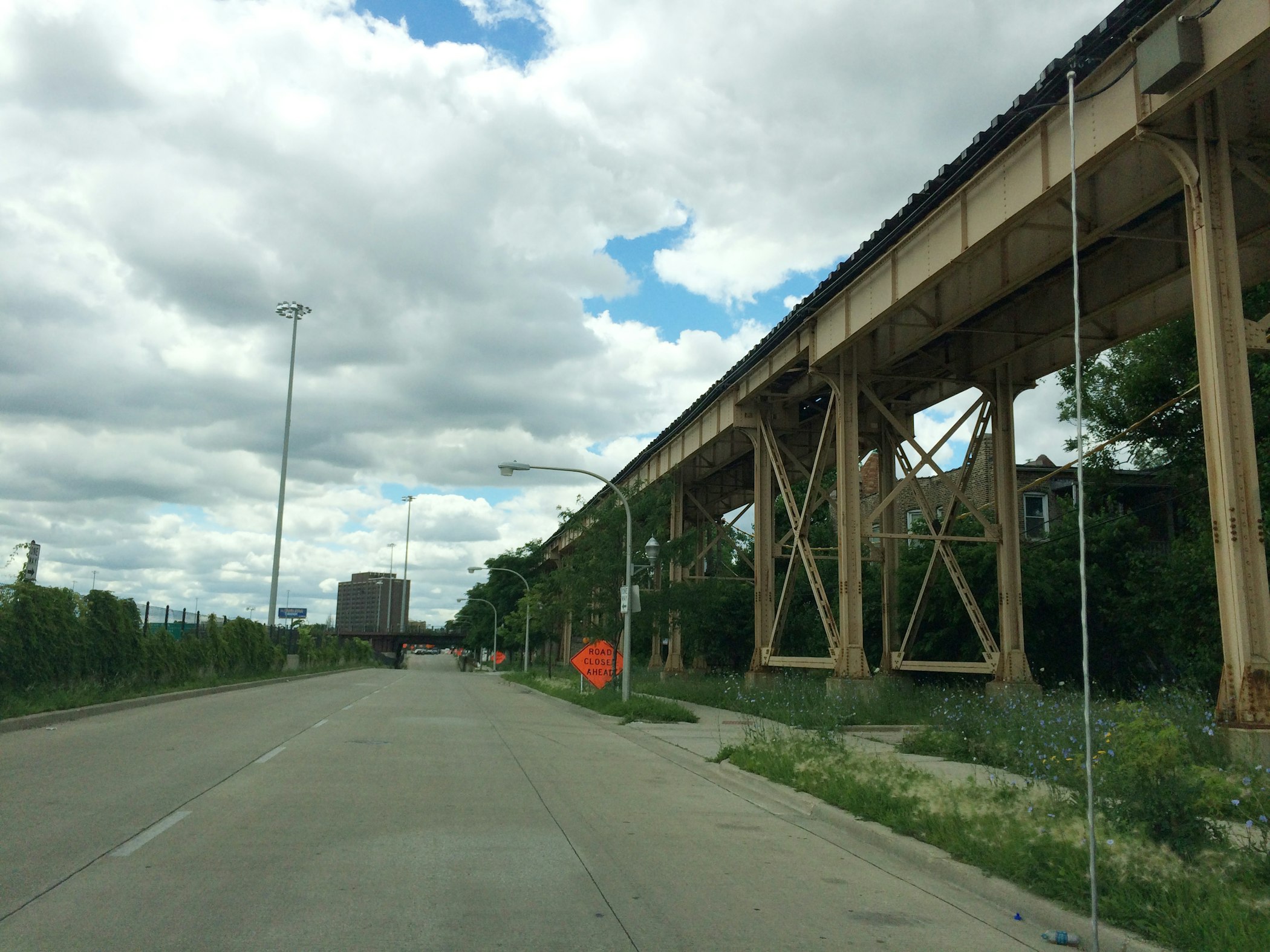
[Fig. 6] Chicago’s elevated Green Line through a neighborhood. © Kathy Velikov, 2014
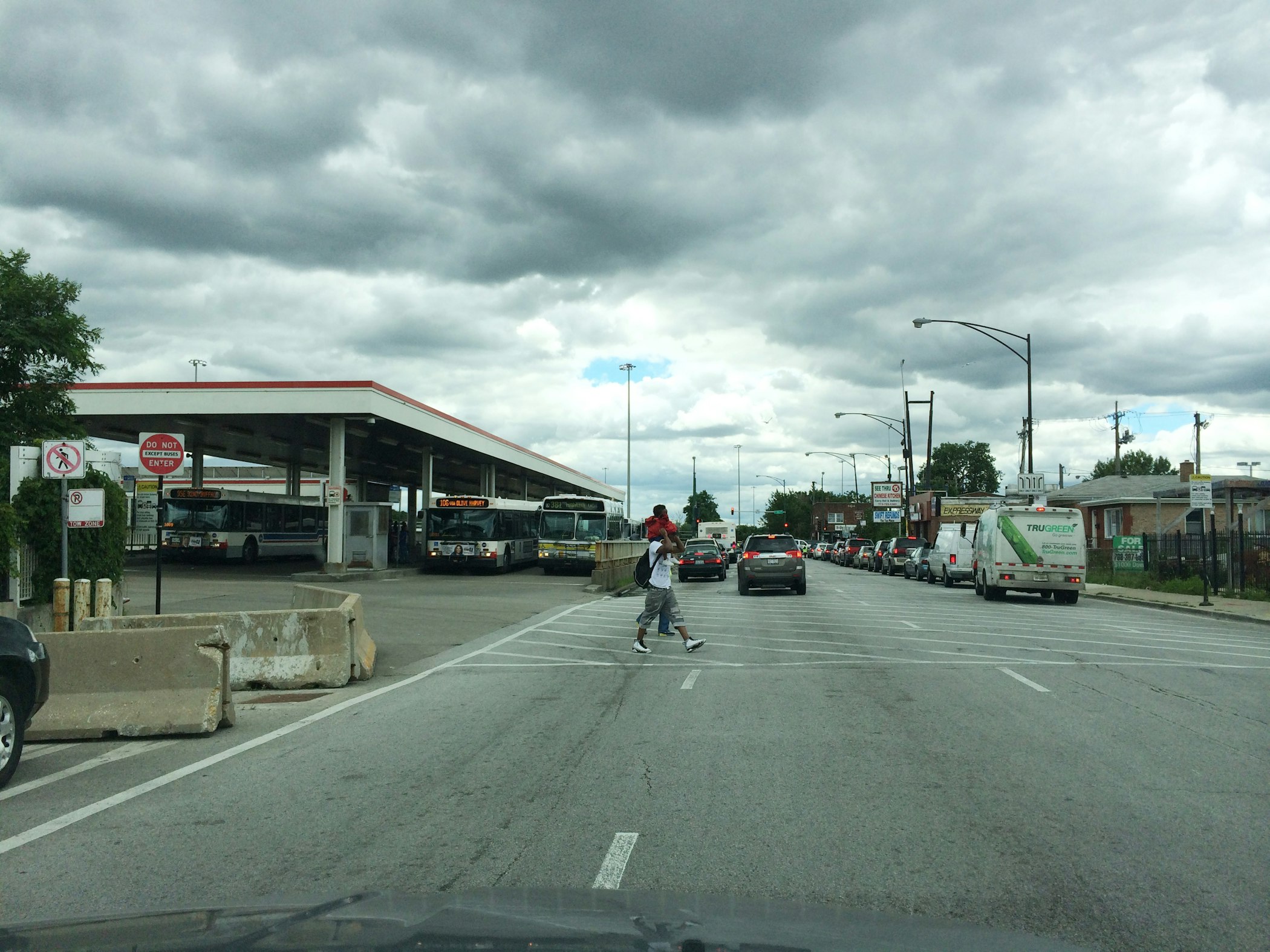
[Fig. 7] Street-level urban condition at the 95th Street Red Line Station © Kathy Velikov, 2014
In this work we think through design as a complex mobilization and assemblage of myriad forces: from the needs of the populations that are connected by and dwell adjacent to these nodes, to the community organizations that could be mobilized as partners in programming activity, to the sources of funding and enterprise that would provide resources for construction and operations, to the institutions and programs that would continue to care for and maintain these spaces and structures over time. The drawings developed by our team are intended to represent simultaneously the design proposition as a spatial and programmatic matrix, and the allied networked forces and mechanisms that might bring the proposition into being, support it, and sustain it within the city. Proposals are developed typologically in their design elements, yet specifically in their assemblage of local actors, instruments, and urban spatial strategies [Fig. 8].

[Fig. 8] Prototype design proposals (l-r): light-intensity prototype at South Lawndale bus route, medium intensity at Washington Park / Garfield Station, and high intensity at the CTA 95th Street Terminal in Roseland. © Velikov and Thün / RVTR 2014.
The prototype developed for the CTA Green Line Garfield Station in Washington Park offers a lightweight urban model for rail-based transit stations with adjacent transit-owned and operated parking lots and/or space beneath elevated rail lines [Figs. 9 &10]. The proposal reorganizes these spaces to assemble a mobile and itinerant public infrastructure that takes advantage of alternative spatial programming during times of low commuter use. Architectural elements consist of a perimeter roof structure that defines the street edge and provides shelter; curbside redesign to accommodate bike share, rideshare, and safe waiting; small-scale pavilions for community group-based education, classes, or meeting activities; landscaping for stormwater management and urban biodiversity; and a recodification of the ground plane that can enable mobile service delivery, temporary pop-up events, open-air markets, and play spaces.
In contrast to the “grand central stations” of the early twentieth century, the federally funded freeway programs of the mid-twentieth century, and the market-driven infrastructural developments since the 1990s, this work seeks an alternative model in crossbreeding mobility infrastructure with social infrastructure. This model is not centralized but distributed and multifold; it is not developed by top-down entities that view local communities as merely “stakeholders” but instead through contingent and imperfect collaborations that work in partnership with local groups and mobilize assemblages of multiple sources of funding. We prioritize everyday life and the use value of urban space over representation and exchange value. Our work is offered not as a singular solution to the complex questions of urban inequality, but as a design-driven thought experiment of viable alternatives and hopeful possibilities for new formats for how we might approach urban “infrastructure(s)”.
A NEXT AGENDA FOR INFRASTRUCTURE
Infrastructure can be conceived as relational networks that enable higher goals, and thus, a new agenda for infrastructure must reassemble flows, materials, and entities toward the needs and empowerment of communities that have been expelled from and ignored by contemporary and historic systems. A new agenda for infrastructure must be articulated from an activist position to enable social change and an emancipatory alternative. Anthropologist Dominic Boyer calls for a “revolutionary infrastructure” that “may not resemble the familiar infrastructures of carbon modernity that currently encompass and enable us.”[36] To this, we would add that this infrastructure will assemble different actors and elements to co-produce alternative subjectivities and commons, and in doing so, outcomes will not resemble the familiar infrastructures of exploitative neoliberal economics and land market-driven urbanization.
A next agenda for infrastructure should aim to cultivate and “more fruitfully inform livable politics and ontologies in current life worlds” through partial, sometimes flawed, nonharmonious yet exuberant co-habitation, co-constitution, and contingency among humans and other species.[37] These infrastructures might leave aside the purely functionalist dynamics of current discourses of urban ecology to instead embrace a post-romanticist and post-capitalist environmental politics of urban nature.[38]
A next agenda for infrastructure would be conceived and materialized in the context of a changed and continually changing climate, where extreme weather, sea-level rise in coastal cities and the inevitable limits of material resources of the planet will require more pliable, lightweight, and adaptive infrastructures for social, mobility, energy, water, food, and waste systems. This will enable smaller, more localized circuits and exchanges that operate at multiple scales and intensities of built and biotic formation most likely in more circular modalities.
A next agenda for infrastructure will not find designers awaiting commissions conceived and funded by centralized sources of capital and power. New collaborations will need to be forged among disciplinary and design experts in collaboration with networks of institutions, organizations, domain expertise, enterprise, and advocates in shaping this agenda and working cooperatively to realize its goals. The flows mediated by public works that emerge from this new agenda will not be limited to management in service of instrumental control but will aim to structure and undergird new staging grounds for more just, heterogeneous, and resilient urban life.
ACKNOWLEDGEMENTS
The RVTR project for Chicago was made possible through seed funding from Alan and Cynthia Berkshire to Taubman College of Architecture and Urban Planning at the University of Michigan through its Research on the City program, funds from the University of Michigan OVPR, and support by the U.S. Department of Transportation, Region V Center, Nextrans Project No. 163UMY2.2—and any opinions, findings, and conclusions or recommendations expressed in this material are those of the author(s) and do not necessarily reflect the views of the U.S. Department of Transportation. Thanks to the project design team who assisted in the work: Dan McTavish, Susan Zielinski, Nick Safley, Anthony Pins, Andrew Wald, Komal Anand, and Ya Suo. We thank Mona El Khafif and Seth McDowell for their editorial comments and suggestions on the original chapter and Malcolm McCullough on his editorial work to refine the text for this publication in Taubman College’s GRADIENT platform.
